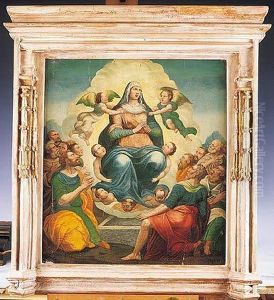Jeronimo Antonio Ezquerra Paintings
Jeronimo Antonio Ezquerra was a significant yet somewhat obscure figure in the world of 17th-century Spanish art. Born in 1630, Ezquerra's life and career were situated in a period rich with artistic evolution, during the tail end of the Spanish Golden Age, a time characterized by flourishing literature, fine arts, and dramatic arts. Not much is documented about his early life, including his training and influences, which is a common issue when studying artists from this era. However, based on the stylistic attributes of his work, it is clear that he was deeply embedded in the Baroque artistic movements that dominated European art at the time.
Ezquerra's body of work primarily consists of religious themes, a common focus for artists of his time, reflecting the Counter-Reformation's emphasis on using art as a tool for religious devotion and instruction. His paintings are known for their dramatic use of light and shadow, a technique known as chiaroscuro, which was popular among Baroque artists and is indicative of the influence of Caravaggio and his followers. Through this technique, Ezquerra was able to imbue his subjects with a sense of divine presence and emotional depth, characteristics that made his works resonate with the religious fervor of the period.
Despite his contributions to the Spanish Baroque movement, Jeronimo Antonio Ezquerra did not gain the same level of fame as some of his contemporaries, such as Diego Velázquez or Francisco de Zurbarán. This lack of widespread recognition could be attributed to several factors, including the possible scarcity of surviving works or limited patronage outside of ecclesiastical commissions. Nevertheless, his paintings that do survive offer valuable insights into the religious and artistic sensibilities of 17th-century Spain.
Ezquerra's career, while not extensively documented, is understood to have been relatively short-lived; he died in 1669, at the age of 39. The brevity of his life undoubtedly influenced the volume of his surviving work, yet what remains is a testament to the skill and spiritual depth of this Baroque artist. Today, Ezquerra's work is studied by art historians and enthusiasts who seek to uncover and appreciate the nuances of Spanish Baroque art, ensuring that his contributions to the artistic heritage of Spain are not forgotten.
